In this quick tutorial you'll learn how to draw a Wood Thrush in 7 easy steps - great for kids and novice artists.
The images above represent how your finished drawing is going to look and the steps involved.
Below are the individual steps - you can click on each one for a High Resolution printable PDF version.
At the bottom you can read some interesting facts about the Wood Thrush.
Make sure you also check out any of the hundreds of drawing tutorials grouped by category.
How to Draw a Wood Thrush - Step-by-Step Tutorial
Step 1: Let's begin our little wood thrush with the head. Draw a curved line with a tiny, pointy beak.
Step 2: Let's detail the face - draw a line to close the beak and a circle for the eye. Draw a line downwards to contour the face.
Step 3: Okay now the body - draw a rounded line for the bird's belly, and a diagonal line for the bird's back.
Step 4: To draw the wing, continue the back line into a point, then draw it up and curve it at the top.
Step 5: Alright, now we can detail the wing. Draw some lines at the base of the wing to make seperation patterns.
Step 6: Draw a rectangular, lined shape for the tail.
Step 7: Finally, draw two small, thin feet with claws.
Interesting Facts about the WOOD THRUSH
The Wood Thrush is a member of the bird family and the scientific term for them is Hylocichla mustelina. This animal is popularly believed to have the most beautiful song in North America. Poets have written about this species, in how the complex and rhythmic sounds that it makes, affect the emotions. For the winter they visit Mexico. It is the official bird of the Capitol of the United States, Washington DC.
Did you know?
- The animal was first documented in 1789.
- This species is over 8 inches in length.
- They have a wingspan of almost 16 inches wide.
- The bird weighs about 2.5 ounces.
- They defend territory over 11,000 square feet wide.
- The bird can live to almost 9 years old.
- They make their nest in trees up to 52 feet tall.
They are white with a brown back, spots on the chest, and pink legs, with females having the same appearance. This species mostly travels alone, but sometimes form flocks with different species of birds. They eat worms and fruit, and in large amounts during the summer season. During mating season, the female makes several circular flight patterns, as the male follows.








